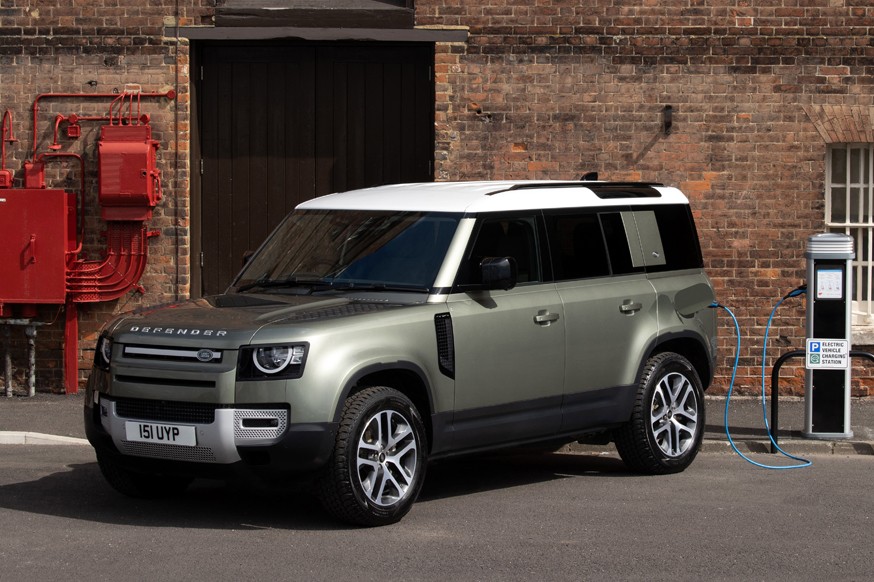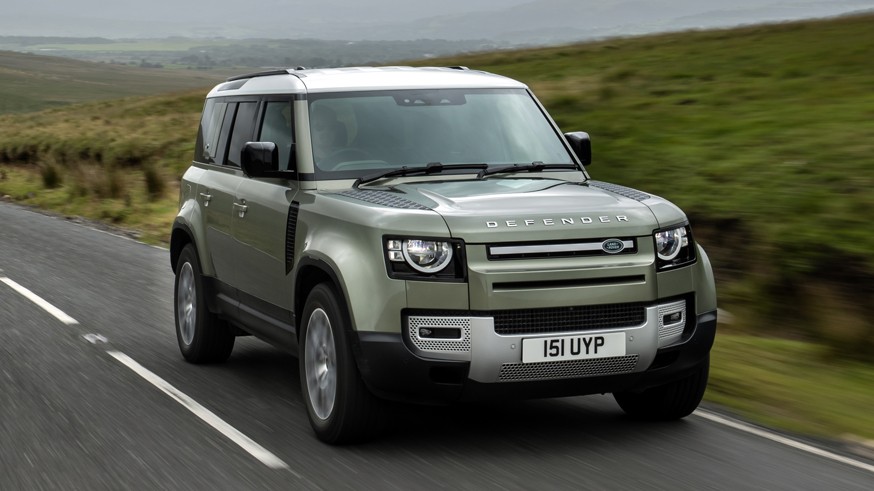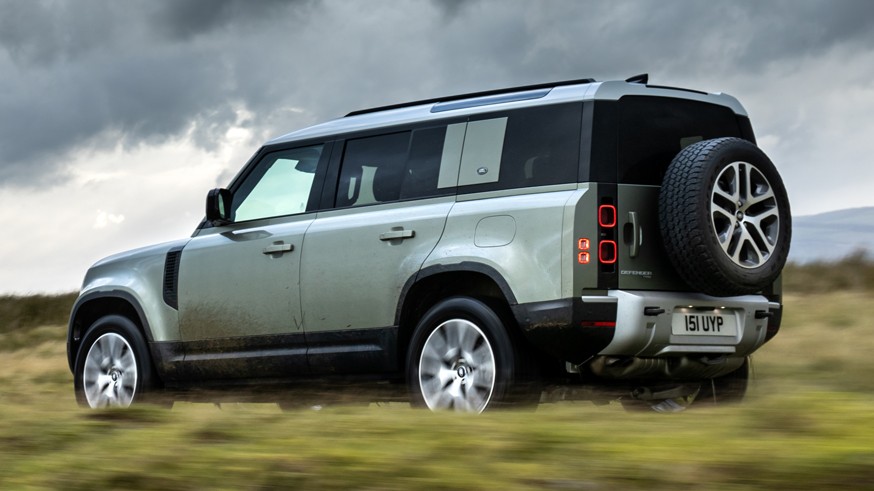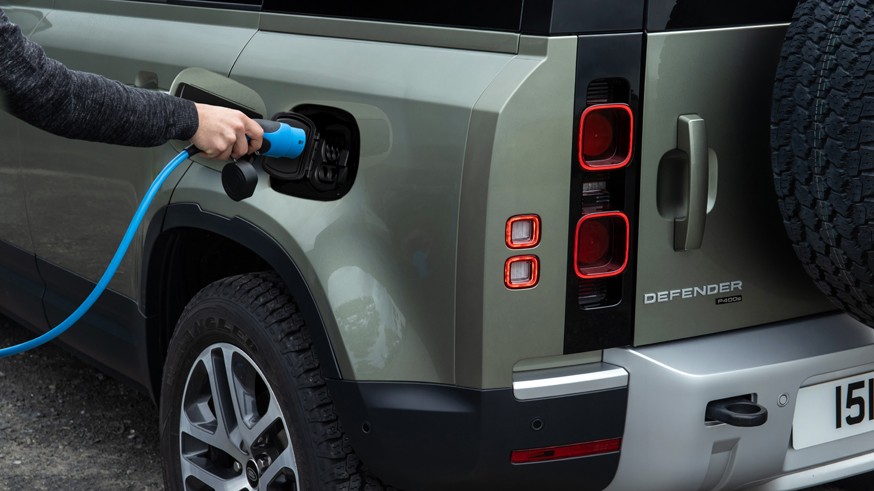- Расширение линейки: Land Rover Defender получил гибридную установку и новый дизель
- Land Rover специально для России упростил дизель нового Defender
- Land Rover Defender P400e plug-in hybrid review
- The electrified version of the beloved off-roader is more efficient and less polluting than its petrol and diesel siblings, but costs significantly more than them, too
- Pros
- Cons
Расширение линейки: Land Rover Defender получил гибридную установку и новый дизель
Компания Land Rover выпускает легендарную модель с 1948 года. Сначала автомобиль назывался просто Series I, II, III и в качестве приставки имел указание на размер колёсной базы в дюймах – 88 и 109. В 1983-ем внедорожники начали называть просто Land Rover 90, 110 и 130 (индекс зависел, опять же, от расстояния между осями). Спустя семь лет модель получила имя Defender. Однако эпоха «классических» Дефендеров уже завершена: последний экземпляр сошёл с конвейера в Великобритании ещё в начале 2016 года. Однако в компании решили не отправлять название в прошлое – теперь имя перешло другой модели бренда. Продажи нового Defender в Европе стартовали весной текущего года.
Презентация новинки прошла в сентябре 2019-го на автосалоне во Франкфурте. Land Rover Defender получил короткобазную (с прибавкой 90 к названию) и длиннобазную (с приставкой 110) модификации. Кстати, первой в серию запустили именно версию с увеличенным расстоянием между осями, а вот с Defender 90 решили повременить (в конце июля мы сообщали о том, что эта версия задерживается из-за «коронакризиса»). Теперь же этот автомобиль появился в продаже. Трёхдверный внедорожник рассчитан на пятерых седоков, но в качестве опции предлагается дополнительное сиденье, раскладываемое между двумя передними креслами.
Теперь у Land Rover Defender появилась новая топовая версия, её роль выполняет подзаряжаемый гибрид с приставкой P400e к названию. Эта модификация получила «начинку» от Range Rover и Range Rover Sport. В основе системы лежит 300-сильная «турбочетвёрка» объёмом 2,0 литра, работающая в тандеме с электромотором с отдачей 143 л.с. и 8АКП. Совокупная отдача установки составляет 404 л.с., а максимальный крутящий момент – 640 Нм. Ёмкость литий-ионной батареи гибрида равна 19,2 кВт*ч, запаса хода при движении только на электротяге хватает на 43 км.
От 0 до 100 км/ч Land Rover Defender P400e разгоняется за 5,6 секунды. Этот результат меньше, чем у версии P400, которая оснащается 400-сильной рядной «шестёркой» (крутящий момент – 550 Нм), работающей в тандеме с 48-вольтовым стартер-генератором. Эта версия набирает первую «сотню» за 6,1 секунды.
Land Rover специально для России упростил дизель нового Defender
Компания Land Rover в процессе российской сертификации внедорожника Defender нового поколения решила отказаться от технологии «мягкого гибрида» MHEV («mild hybrid») для «старшего» дизельного мотора мощностью 249 лошадиных сил. Об этом сообщает пресс-служба британской марки (релиз поступил в редакцию РБК).
Таким образом, двигатель останется без системы с 48-вольтовым стартер-генератором с ременным приводом. Стартер-генератор выступает в роли вспомогательного электромотора, который подключается при резком старте или при езде на малых скоростях, обеспечивая дополнительную тягу и снижая, тем самым, расход горючего. Не будет и системы рекуперативного торможения, при которой энергия возвращается в электрическую сеть, что также влияет на топливную экономию. Причины отказа от технологии MHEV не называются.
При этом 400-сильный бензиновый мотор, работающий по такому же принципу «мягкого гибрида», останется в линейке двигателей нового Land Rover Defender для российского рынка.
Британцы объявили о старте приема заказов на внедорожник Defender нового поколения в начале сентября 2020 года. Цены на автомобиль, доступный в трех- и пятидверном кузове, варьируются от 4 060 000 руб. до 7 042 000 рублей. Первые автомобили появятся у дилеров в конце осени.
Стандартное оборудование модели предусматривает адаптивную пневматическую подвеску, светодиодные головные фары, двухзонный климат-контроль, систему кругового обзора, а также мультимедийный комплекс с навигатором.
У более дорогих версий версий нового Land Rover Defender есть кожаный салон, виртуальная приборная панель диагональю 12,3 дюйма, матричные фары, адаптивный круиз-контроль, сиденья с электрическими регулировками и вентиляцией, а также системой ионизации воздуха в салоне.
Новый Land Rover Defender дебютировал в сентябре 2019 года в рамках Франкфуртского автосалона. Преемник знаменитой модели, продержавшейся на конвейере около 70 лет, остался без классической рамной конструкции и механической коробки передач. Внедорожник получил несущий кузов на основе алюминиевого монокока, а также полностью независимую подвеску и постоянный полный привод.
Land Rover Defender P400e plug-in hybrid review
The electrified version of the beloved off-roader is more efficient and less polluting than its petrol and diesel siblings, but costs significantly more than them, too
Pros
- Electric driving range
- Rapid charging standard
- More efficient than petrol or diesel siblings
Cons
- High price
- Only available as five-door
- Rivals better on emissions and economy
The electrification of Land Rover’s vehicle line-up is fully underway, with six battery-powered models coming in the next five years and a hydrogen fuel-cell vehicle also in development. While a fully zero-emissions car from the brand has yet to go on sale, this plug-in hybrid version of the Defender is here to help off-road enthusiasts and family buyers improve their fuel consumption and reduce their overall emissions.
Land Rover has launched plug-in hybrid variants of the Range Rover, Range Rover Sport, Velar, Evoque and Discovery Sport, so the electrified variant of the Defender came as little surprise. It uses a 2.0-litre, four-cylinder petrol engine coupled with an electric motor powered by a 19.2kWh battery pack. You can find the same powertrain in the F-Pace P400e SUV from sister company Jaguar.
According to Land Rover, the Defender’s hybrid setup allows for up to 27 miles of pure-electric driving and a top speed of up to 87mph in EV mode. The plug-in Defender will return between 72 and 85mpg fuel economy depending on spec and trim level, which isn’t quite as impressive as the 130mpg yielded by the Jaguar counterpart. The Defender’s claimed electric range and fuel-economy figures also rank poorly compared with other electrified SUV rivals from BMW, Mercedes, Audi and Volvo.
The BMW X3 xDrive30e, Mercedes GLC 300 e and Jaguar F-Pace P400e also produce slightly less CO2, with the plug-in Defender emitting between 74 and 88g/km, which again depends on spec. However, those figures are low enough for the electrified Defender to qualify for a 20% Benefit-in-Kind (BiK) company-car tax rate, starting at £2,079.
But the Defender P400e isn’t just for company-car drivers: Land Rover thinks it’ll be popular with private buyers, too. Thanks to the hybrid unit, the electrified Defender offers reduced running costs and strong performance, second only to the top-of-the-range Defender V8. Combined, the plug-in Defender produces 398bhp and a whopping 640Nm of torque, which allows the 2.6-tonne car to accelerate from 0-62mph in just 5.6 seconds.
This Defender has already proved itself to be a well-rounded vehicle, with the road manners of a modern SUV.
The addition of the hybrid unit hasn’t affected the ride quality: the Defender is still surprisingly sharp to turn in, while the suspension also remains slightly firmer than the Discovery’s.
There aren’t many noticeable differences between this plug-in Defender and the combustion-engined version, aside from the addition of a charging port on the left rear wheelarch and pure-electric driving ability. You still get the full suite of Terrain Response off-road functions, as well as some electric off-road functions, including a low-range setting for the electric motor. Inside, you get a 12.3-inch driver’s display and a 10-inch infotainment touchscreen with Apple CarPlay and Android Auto connectivity.
However, it’s worth noting that the Defender P400e is only available in five-door, longer-wheelbase 110 guise and in X-Dynamic and XS Edition trim levels. The plug-in Defender gets an impressive 853 litres of boot space with the rear seats in place, although the hybrid system does eat into that space slightly.
Rated ‘Excellent’ Trustpilot
On start-up, the Defender defaults to Hybrid mode, which allows the car to switch between the engine and electric motor depending on what it calculates to be the most efficient. Thankfully, the way it shuffles between the two is almost undetectable, and when running on electric power only, the Defender is extremely refined and quiet. But when the four-cylinder kicks in, it’s noticeably less smooth than the six-cylinder petrols and diesels found elsewhere in the range.
Save mode ensures that the car’s battery retains a certain amount of energy, and will see you rely more on the petrol engine. Of course, in EV mode you can enjoy zero-emissions driving even on the motorway, although given the boxy design of the new Defender, the wind noise when travelling at higher speeds is noticeable.
In terms of running costs, when we tested the plug-in Defender across a mix of roads, we saw up to 40mpg from the display – less than half of the official figure. However, even the lower figure we saw is more economical than the rest of the Defender line-up, so as long as you keep it charged, the PHEV could be an affordable-to-run alternative to its petrol and diesel siblings.
Charging the Defender P400e is simple, too. Recharging the battery to 80% will take two hours from a 7kW home wallbox and the car’s 50kW rapid-charging capability (unusual for a plug-in hybrid) means that if you find a fast enough public charging point, you can replenish to 80% in just 30 minutes.
Ultimately, the plug-in hybrid version of the Defender is a brilliant, more efficient version of the beloved off-roader. However, you need to stay on top of charging if you’re looking to match the official economy number, and you need to shell out a fair bit in the first place, too, with prices starting from over £65,000 – £15,000 more than the plug-in variants of the BMW X3, Audi Q5, Volvo XC60 and Mercedes GLC.








